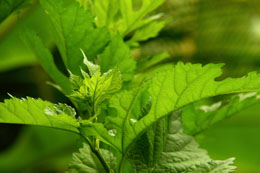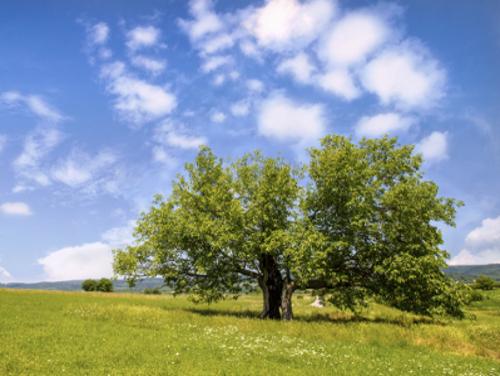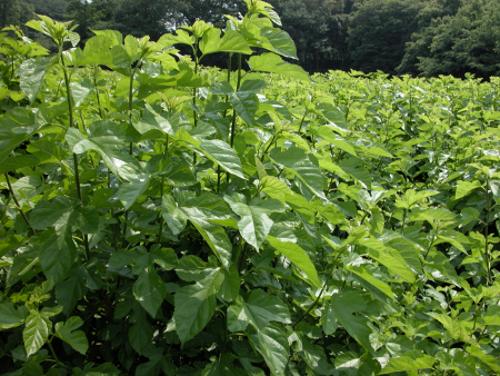The fruitless mulberry tree is an excellent choice to be made as a landscape tree for the garden. In this following Buzzle article, we will go into further detail about this very interesting species and give you pointers on how to grow them.

The fruitless mulberry tree―botanically known as
morus alba―is a genus of 10-16 species of deciduous trees. This non-bearing tree, sometimes known as the male trees of the white mulberry, has been in use in China for over 4,000 years as the primary food source for silkworm larvae. The silkworm has been the sole reason for fueling the ancient Chinese textile industry, and continues to do so even today―not just in China but in many other Asian countries as well.
The tree was introduced in North America for the very same reason―to provide a natural food source for a potential silkworm industry. Though the intended industry never realized its potential in the country, the tree with its graceful spreading branches became an excellent alternative to fruiting mulberry trees, especially for landscape uses. In fact, the fruitless variety of the mulberry is a preferred choice when compared to the fruit-bearing variety for two main reasons;one, it does not litter the ground with fallen berries, which have a tendency to stain the ground, and two, the fallen berries are not eaten and the seeds disbursed by birds, thus causing the tree to become an invasive species.
Details
The fruitless mulberry tree develops a very dense and round-topped crown, and the tree itself could grow to a height of 20-60 feet, with a trunk that may be as wide as 45 feet wide. The result is that, it provides for a deep and shady foliage and makes for a lovely addition to any landscape. Some varieties within this cultivar have a drooping appearance of a gigantic creeper. The young branches may have a orange-colored tinge to them, which is lost as the tree matures. Though the tree is deciduous in temperate regions, when grown in a tropical climate, it can be evergreen as well.
Although a tall tree, the fruitless variety can be shaped to have a central leader with a short, stout trunk and a crown made from lateral branches.

The fruitless mulberry tree in a field
On young shoots, the leaves of the tree grow up to 30 cm long, and are intricately, roundly lobed. On older trees, the leaves are 5-15 cm long and are unlobed, heart-shaped at the base, having serrated tips that narrow to a slender tip.

The leaves of the mulberry tree
How to Grow a Fruitless Mulberry Tree
Tree Care:
This tree can be easily propagated through cuttings of young wood or even mature wood. They are fast growers and non fussy. They do well in most soils, but prefer a soil with a pH of 6.1 to 6.5. However, it is best to avoid heavy clay soils. These trees need full or partial sun and it has been observed that they do not grow half as well in shade. The fruitless mulberry likes to be watered well but being drought-resistant will tolerate dry spells too.
Tree Roots:
These mulberry tree roots are shallow and lateral, and not deep ranging. This causes a problem because roots have a natural tendency to head towards a water source, and being lateral roots, these will definitely try to get into sewage and other water pipes, mostly by breaking into them. Which is why it is necessary to choose a site with care. For established trees, a root prune is generally recommended. Get professional help to look into the mulberry tree root system and cut out undesirable roots. It is necessary to employ professionals because the wrong trimming could cause the tree to die.
Yellowing of Leaves:
To ensure that the lushness of your mulberry tree does not turn yellow, pay attention to the fungus that generally infects the underside of the leaves and the quantity of water given to the tree. The varied fruitless mulberry tree diseases affecting this tree include
mulberry leaf spot which affect the leaves, and
cotton root rot that sets in the roots, which will lead to yellowing of the leaves. Both these diseases can be treated, though root rot is a little difficult to contain. Not supplying enough water to the plant is another cause for leaves yellowing. The roots of this tree are shallow and tend to dry up quickly, hence always water deeply and regularly.
Pruning:
Always prune the fruitless mulberry after it has shed its leaves. A pollard tree pruning technique is applied especially for this variety. Since the idea is to maintain a short, stout trunk, this method encourages vigorous, leafy, lateral branching growth near the trunk of the tree. However, this method must be applied when the tree is young, since established trees can get damaged in the process. In this method, most of the branches that are 1 to 2 inches from the main stem (intended trunk) are cut off, resulting in closely spaced shoots to appear laterally. Prune any other branch that may grow out farther down on or from the trunk. If you do not want to follow this method, give your tree an overall prune in fall, and cut back all out-of-shape, damaged, diseased, or broken branches.
The only problem with the fruitless mulberry tree is its extremely fast growth, shallow lateral roots, and requirement of plenty of water, but if you can get around to them, you will be graced with a beautifully shaped, thick and shady tree gracing your landscape.






 The fruitless mulberry tree―botanically known as morus alba―is a genus of 10-16 species of deciduous trees. This non-bearing tree, sometimes known as the male trees of the white mulberry, has been in use in China for over 4,000 years as the primary food source for silkworm larvae. The silkworm has been the sole reason for fueling the ancient Chinese textile industry, and continues to do so even today―not just in China but in many other Asian countries as well.
The fruitless mulberry tree―botanically known as morus alba―is a genus of 10-16 species of deciduous trees. This non-bearing tree, sometimes known as the male trees of the white mulberry, has been in use in China for over 4,000 years as the primary food source for silkworm larvae. The silkworm has been the sole reason for fueling the ancient Chinese textile industry, and continues to do so even today―not just in China but in many other Asian countries as well.
